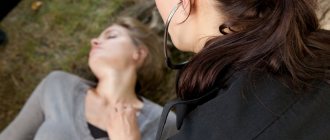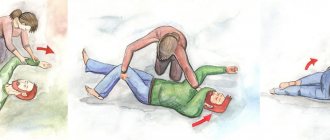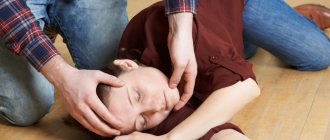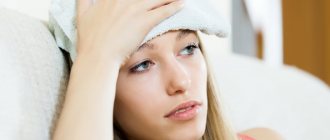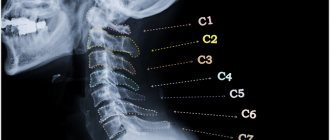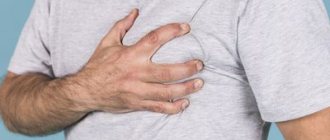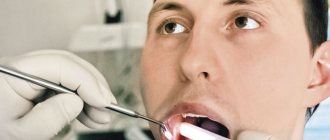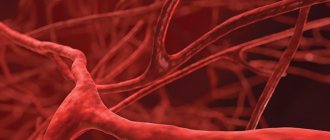According to statistics, every 5 patients at an appointment with a neurologist may experience a burning sensation in the back of the head. These symptoms may include pain, high blood pressure, a feeling that the heart is about to “jump out”, a feeling of anxiety, frequent dizziness, redness of the eyes, patients complain that the back of the head is burning and baking. Why does the back of my head burn? The answer is in this article.
The pain can be so intense that the neck and back of the head literally “burn” with fire. This kind of burning pain is dangerous. A person cannot endure such pain and almost always suppresses it with painkillers. It is not recommended to carry out self-treatment until the exact cause of the heat in the head is determined.
Pain in the back of the head and neck brings a lot of suffering to a person
There are quite a few reasons that cause a burning sensation in the neck and back of the head. These include inflammation, hormonal imbalances, and insufficient blood flow to the brain. The main diseases in which the back of the head and upper back burn:
- cervical osteochondrosis;
- muscle spasms;
- arterial hypertension;
- VSD – vegetative-vascular dystonia;
- migraine, cephalalgia (headache);
- high body temperature due to inflammatory processes.
Often, a burning sensation can occur not only in the head, but also in the shoulders, neck, and chest. Each of these signs is associated with a specific disease. In the article we will pay special attention to the symptoms and treatment of burning pain in the back of the head.
In this article we will tell you in detail about the causes of a burning sensation in the back of the head, treatment with medications, and help at home.
How symptoms may appear
A burning sensation in the scalp can manifest itself in different ways:
- burning inside the head;
- attacks appear periodically;
- feeling as if overheated in the sun;
- tightening of the skin on the head;
- monotonous throbbing pain inside the head;
Throbbing pain in the head can indicate many diseases - heat in forehead;
- pulls the throat and neck;
- pain in temples;
- girdle pain - it seems to arise inside and covers the entire head;
- burning in the cervical region.
Factors that provoke a burning sensation in the back of the head
For many people, the back of the head and ears may “burn” due to external factors, and not due to illness. To eliminate discomfort, you just need to change your lifestyle and habits.
The following factors can provoke the appearance of a burning sensation in the head and neck:
- Smoking and alcohol. Harmful substances enter the blood and lead to vasoconstriction. The body begins to receive less oxygen, which leads to headaches. If you stop drinking and smoking, the symptoms will go away within 2 weeks;
Cigarette composition - Severe fatigue and overwork. High physical and mental stress negatively affects the human autonomic system and therefore blood circulation in the vessels is disrupted. To eliminate symptoms, you need to get enough sleep and avoid overexertion;
- Sedentary lifestyle. Constant sedentary work at the computer and lack of exercise leads to a slower metabolism and poor blood circulation. Painful sensations may decrease by rubbing the back of the head;
- Constant stress and nervous tension;
- Hormonal disbalance. As a rule, this occurs in girls during pregnancy or menopause. This leads to disruptions in the functioning of the heart and provokes painful symptoms in the head and back of the head;
During pregnancy, the head and back of the head may sometimes hurt - Allergies to food, shampoos or cosmetics.
Itchy scalp
Fungus
Allergy
Diabetes
88487 November 17
IMPORTANT!
The information in this section cannot be used for self-diagnosis and self-treatment.
In case of pain or other exacerbation of the disease, diagnostic tests should be prescribed only by the attending physician. To make a diagnosis and properly prescribe treatment, you should contact your doctor. Itching of the scalp: causes of occurrence, what diseases it occurs with, diagnosis and treatment methods.
Definition
The desire to scratch your head is probably familiar to everyone. For some people, head scratching is associated with emotional stress, for others it is due to improper hair care, and for others it is a symptom of a dermatological problem or a disease of internal organs and systems.
Types of skin itching
Skin itching can be chronic (more than 6 weeks) or situational in nature, being a protective reflex aimed at removing irritating substances or objects that have reached the surface of the skin.
Scalp itching is classified according to the same principle as any other skin itching:
- dermatological or pruritogenic itching (for skin diseases - atopic dermatitis, psoriasis, scabies, lice, etc.);
- systemic itching (with pathologies of internal organs - primary biliary cirrhosis, Hodgkin's disease, etc.);
- neurological/neuropathic (with damage to the nervous system);
- psychogenic (with stress and emotional tension);
- idiopathic (unknown etiology);
- somatoform (for mental disorders);
- multifactorial (with a combination of two or more of the above factors).
Possible causes of itchy scalp
Pathologies of the scalp
- Dryness of the epidermis.
It occurs as a result of disruption of the sebaceous glands, manifested by a decrease in sebum production, which leads to brittle hair, the appearance of fine dandruff and hyperreactivity (increased sensitivity) of the skin. - Mechanical or chemical traumatic effects on the scalp
. Such influences include frequent use of hair styling products, sharp combs, drying hair with hot air, dyeing hair with aggressive dyes, and washing hair with shampoos containing aggressive surfactants. - Muscle strain
often develops in people who prefer tight hairstyles with long-term rigid fixation of hair, as well as in those whose occupation requires staying in the same position for a long time. Such overstrain causes spasm of the back muscles, neck-collar area and impaired microcirculation, which, in turn, leads to unpleasant painful sensations in the scalp and itching. - Pediculosis
. Lice infestations still occur in the population. It occurs from an infected person using common household items (combs, towels), clothing (hats, hair bands).Itching of the scalp develops at the sites of lice bites.
- Fungal infections of the scalp
are much less common than fungal infections of the nails, but are less treatable. They manifest as brittle hair (often at the base), severe itching, the appearance of dandruff and pink spots that rise above the surface of the skin. - Lichen
– pathology of fungal or viral etiology, which also leads to itching of the scalp.The clinical picture of this disease: itching and burning of the skin, flaky pink or scarlet spots surrounded by irritated skin.
A characteristic feature of ringworm is hair loss in the affected areas. The skin in the lesions is light, flaky, and very itchy.
- Demodicosis
. The causative agent is a microscopic iron mite of the genus
Demodex
, living in hair follicles and sebaceous glands. The disease is manifested by redness of the skin, nodules, pustules and acne, brittle hair, constant itching, and a large amount of dandruff.Demodicosis can spread to other areas of the skin - face, eyelids, neck, area behind the ears.
Pathologies of body systems
- Seborrhea
– a pathological condition of the skin, characterized by increased production of sebum and, as a result, thickening of the dermis as a result of a malfunction of certain body systems (nervous, endocrine, reproductive).Seborrhea can develop in patients with diabetes mellitus, Parkinson's disease, and acquired immunodeficiency syndrome.
There are the following forms of seborrhea - dry, oily, mixed. Dry seborrhea is most often localized on the face (seborrheic dermatitis), oily - on the scalp. Clinically, seborrhea is manifested by severe itching and soreness of the scalp; the hair acquires an oily sheen, whitish scales appear in them, which tend to stick together directly on the skin, forming areas of red or brown inflammation - when traumatized (for example, when combing), bleeding wounds appear on them.
- Hypovitaminosis
. Often, a lack of essential vitamins and microelements leads to damage to epidermal cells, as evidenced by dry skin, its excessive sensitivity, fragility and increased hair loss, itching. - Frequent stress
may cause itchy scalp. This is explained by the increased release of adrenaline into the blood, which leads to peripheral vasoconstriction (vascular spasm) and, as a consequence, to a deterioration in blood supply and nutrition of the epidermis.
- Allergies
are one of the most common diagnoses. In most cases, the manifestations of the disease are not limited to rashes only on open areas of the body; the lesion is also localized on the scalp, causing itching. The skin of the extremities and torso is characterized by urticarial rash elements (blisters) - from red to pale pink (with urticaria), lacrimation, swelling of the eyelids and their redness (with allergic conjunctivitis). Difficulty in nasal breathing, itching in the nose and sneezing are observed with allergic rhinitis. - Neurodermatitis
can also cause itchy scalp. The disease is characterized by increased symptoms during periods of emotional stress, the appearance of small itchy plaques, most often localized on the back of the head, neck, genitals, and in the intergluteal fold. - Poisoning of the body with conditionally toxic and toxic substances
- aluminum, beryllium, mercury, etc. The presence of high concentrations of these substances in the body causes both systemic manifestations of poisoning and local ones - hair loss, a feeling of scalp discomfort, including itching. - Hypothyroidism
is a disease associated with a decrease in the production of thyroid-stimulating hormones, one of the symptoms of which may be itching caused by dryness of the epidermis.
Which doctors should I contact?
If itching of the scalp occurs, you should contact a trichologist or dermatologist, who will help determine the cause of the pathology and prescribe the necessary examinations.
Diagnosis and examinations for itchy scalp
Diagnosis of head lice involves a thorough examination of the patient's head to detect lice and nits.
To identify fungal infections, a cytological examination is performed.
If hypovitaminosis is suspected, the doctor may prescribe a series of blood tests to verify the diagnosis - for example, determining the concentration of vitamins, the lack of which causes deterioration in the condition of the skin, hair and nails.
Diagnostics: how to examine a patient
Before treating burning pain in the back of the head, you must make an appointment with a therapist, neurologist and ophthalmologist.
Doctors should prescribe the following types of examination of the body:
- general or biochemical analysis of blood and urine;
- checking the fundus using a special apparatus;
- electroencephalography is a method for finding large tumors based on the Doppler effect using ultrasound. This method records electrical impulses in the brain, builds a graph based on them and shows whether a person has epilepsy or other brain abnormalities.
Echoencephalography - daily monitoring of blood pressure (blood pressure). This monitors a person's blood pressure for 24 hours. This method most accurately determines whether a person has hypertension.
Daily blood pressure monitoring - computed tomography (CT). This method diagnoses various head diseases.
- Ultrasound of the vessels of the head.
- magnetic resonance imaging (MRI). This is an X-ray examination of vascular and other pathologies. The method is harmless, unlike x-rays.
MRI of the brain
Doctors also use the method of differential diagnosis - this is finding a disease by exclusion.
Diagnostic and treatment methods
The Clinical Brain Institute offers individualized screening programs to help determine the cause of your headaches. Procedures are prescribed only according to indications. Among them are electroencephalography, radiography of the cervical spine, MRI, Doppler sonography, laboratory blood tests and other techniques.
As a result of a complete examination, a diagnosis can be made and treatment can be prescribed. When selecting medications, doctors at our clinic take into account the patient’s general condition and the body’s response to taking medications. The process takes place under the supervision of specialized specialists, even if it takes place at home.
Clinical Brain Institute Rating: 4/5 — 40 votes
Share article on social networks
Complex of medical procedures
If a burning sensation in the back of the head appears due to cervical osteochondrosis, then the following complex treatment is prescribed:
- NSAIDs – non-steroidal anti-inflammatory drugs in the form of tablets, ointments and injections: Ibuprofen, Diclofenac, Ortofen. They cope with pain.
- Muscle relaxants: Sirdalud, Mydocalm. The drugs relax the neck muscles well.
Sirdalud - Chondroprotectors: Artra, Chondrolone, Chondroxide, Dona. Improves the condition of bone tissue and prevents its destruction.
- Anti-inflammatory ointments: Voltaren Emulgel, Finalgon. Relieves inflammation, improves tissue metabolism.
Physiotherapeutic procedures:
- electrophoresis;
- massage;
- physiotherapy;
- manual therapy;
- Kuznetsov applicator.
When carrying out these procedures, complete disappearance of pain is possible for a long period.
If a cardiologist has discovered arterial hypertension, then the disease is treated with the following means:
- Beta blockers. They reduce the amount of blood ejected by the heart: Bisoprolol, Metoprolol.
Bisoprolol - Antispasmodics: Drotaverine, Papaverine. They dilate blood vessels and reduce blood pressure.
- Drugs that block calcium channels: Nifedipine, Amlodipine.
- Diuretics that remove excess fluid from tissues: Veroshpiron.
For intracranial hypertension the following is used:
- Diuretics: Veroshpiron, Furosemide.
Veroshpiron - Vasodilators: Cavinton, Cinnarizine.
The use of these drugs in combination improves blood circulation and eliminates arterial hyperemia of the brain - overflow of blood vessels.
For attacks of tension-type headaches, muscle relaxants are prescribed to relieve facial muscle spasms.
For a burning sensation in the back of the head as a result of stress, the following procedures help well:
- relaxing massage;
- physiotherapy;
- taking medicinal baths;
- rejection of bad habits;
- daily walks in the fresh air.
To eliminate the symptoms of VSD and panic attacks, make an appointment with a neurologist. Nootropic and sedative drugs are usually prescribed. They normalize blood circulation and slow down pathological processes in the central nervous system.
Burning pain in the head can be relieved by normalizing blood pressure, improving sleep quality, or practicing swimming, yoga, or meditation. It is important to follow a special diet.
Helpful advice! Keep a special notebook where you will write down when and why the pain occurred. Once you find triggers, try to avoid them in the future.
If the back of your head begins to “burn” due to extreme fatigue, then you can make an appointment with a psychotherapist and start taking sedative medications. It will be useful to exchange mental labor for physical labor or vice versa. Take a vacation.
Treatment
Help before diagnosis
A symptom caused by physiological reasons can be prevented: avoid excessive duration and intensity of physical activity, minimize stressful situations. Hot flashes to the head should not be ignored, as they may be the first symptom of serious cardiovascular or neurological disorders. If attacks occur frequently or are accompanied by deterioration in health, you should consult a doctor.
Conservative therapy
Most treatment for hot flashes occurs on an outpatient basis. Among the non-drug methods in the foreground are exercise therapy and dosed physical activity, which improve the state of autonomic regulation. In order not to provoke attacks, they select a diet with a limitation of pungent and extractive substances. Psychotherapy sessions are recommended to correct the emotional state.
The drug regimen is drawn up taking into account the cause of hot flashes. To normalize the functioning of the autonomic nervous system, sedatives, “daytime” tranquilizers, and antidepressants are used. Women experiencing menopausal syndrome undergo hormone replacement therapy, which quickly eliminates unpleasant symptoms. Men during menopause are also prescribed hormones - testosterone in tablet, injection or transdermal form.
In the treatment of hot flashes to the head, physiotherapeutic techniques play an important role. A good restorative and tonic effect is provided by balneotherapy (circular showers, carbon dioxide and radon baths), exposure to electric currents (interference therapy, electrical stimulation, diadynamic therapy). Methods of homeopathy and physiotherapy are shown as an addition to the main treatment regimen.
Patients who complain of redness and heat of the head due to the use of antihypertensive drugs (nitrates) should discuss therapy with their doctor and clinical pharmacologist. In some cases, it is necessary to adjust the dose and frequency of administration, and in case of severe iatrogenic hot flashes, drugs from other pharmacological groups are used.
First aid for a burning sensation in the back of the head
If there is a burning sensation in the back of the head, then you need to measure your blood pressure and examine your head for injuries. If everything is in order, then you need to follow these recommendations to reduce symptoms:
- wet a towel with cold water and apply it to the back of your head;
- massage or self-massage of the cervical-collar area, use of massagers for the cervical-shoulder area.
- avoid bright lights and loud sounds;
- take a relaxing bath with salt;
Relaxing bath - take a break from everything for half an hour.
In this case, the attention and support of loved ones and receiving positive emotions are very important. For repeated attacks, make an appointment with a therapist.
Why does the back of the head and neck burn?
Problems with a burning sensation in the back of the head are often associated with diseases of the cervical spine. Increased sensitivity of the skin provokes increased local capillary circulation. This leads to the fact that a person feels that the back of his head is burning, and additional unpleasant sensations may arise.
If the burning sensation is accompanied by the following symptoms:
- dizziness and severe muscle weakness;
- feeling of lack of air when taking a deep breath;
- nausea and vomiting;
- muscle cramps;
- weakness in arms and legs;
- Strong headache,
then you should immediately call an ambulance team. This condition can be triggered by a sharp increase in blood pressure and, as a consequence, the threat of ischemic or hemorrhagic cerebrovascular accident.
If the back of the head and neck burn strongly, then it is necessary to rule out, first of all, compression of the radicular nerves. Usually this condition accompanies long-term cervical osteochondrosis. Patients experience regular pain in the neck and collar area. There may be tingling in the upper extremities, weakening of muscle strength, etc. A sudden burning sensation may indicate that disc protrusion has developed to such an extent that compression of the radicular nerve responsible for the innervation of the occipital part of the head has occurred.
Only an experienced vertebrologist or neurologist can answer the question of why the back of the head burns and how to cope with this negative symptom. In our manual therapy clinic you can get a free initial consultation with a vertebrologist and neurologist. To do this, just call us and make an appointment at a time convenient for you.
Exercises to relieve pain and burning in the back of the head
To get rid of a burning sensation in the back of the head, you can use an accessible, and most importantly free, method - a set of therapeutic exercises and self-massage.
What exercises should you do to stop headaches and burning in the back of your head?
- Sit with your back straight and your gaze straight ahead. Tilt your head left and right, trying to reach your ear with your shoulder. Repeat 15 times.
- While sitting on a chair, tilt your head down for 30 seconds. Straighten up, wait half a minute and repeat again. Number of repetitions – 15 times.
- Using your middle fingers, find a point below the back of your head at the beginning of your neck. Place your fingertips on it, make 15 movements clockwise, and then press on it for 1-1.5 minutes. Rest for a couple of minutes. Repeat the exercise 5 times.
- The exercise is performed sitting with a straight back. Gently turn your head to the left and slowly move your head towards your right shoulder, your chin should outline a semicircle, pressing against your chest. Bringing your head to your right shoulder, roll it back, trying to reach your back with your occipital region. Slowly return to the starting position. It is advisable to learn how to make a full circle. Repeat 10-15 times.
- Performed in the same position. Raise your shoulders up as much as possible, try to reach your earlobes. Freeze in this position for a few seconds and lower your shoulders back. Repeat 15 times.
- Move your shoulders first forward and then back, trying to mentally draw circles with them. Repeat 10 times.
Be sure to read: TOP 10 methods for quick treatment of lumbar osteochondrosis at home: gymnastics, medications, prevention
Perform all exercises without overstraining your muscles, with smooth movements.
Video: exercise for headaches in the back of the head
Self-massage for burning in the back of the head
- start the massage by kneading your ears with your palms;
- then place your palms on your ears and massage your head with your fingertips;
- then start massaging the occipital area without lifting your palms from your ears.
Yoga is very useful, the main thing is to conduct classes with a qualified specialist.
Yoga significantly improves the condition of the body
Don't forget about manual therapy. When sessions are carried out by a professional chiropractor, the pain can go away for six months or more. Treatment in this case is carried out only in courses.
Prevention
To prevent a burning sensation in the back of the head, you must adhere to the following rules:
- exclude fatty, spicy, salty foods, chocolate from the diet;
- give up alcohol and smoking;
- limit physical and mental stress on the body;
- try to rest more during the day;
- massage the neck and back of the head daily;
- enhanced blood pressure control.
Helpful advice! Set an alarm every 20 minutes when you work at the computer for a break. Stretch or do therapeutic exercises. This will help prevent tension in the neck and a burning sensation in the back of the head.
Patient Questions
Question: I am 30 years old. I often have burning pains in my head, as if it were on fire. The pressure is sometimes low, severe dizziness and the back of the head burns and moves to the side. I work at the computer and rarely go for walks. What happened with me?
Answer : You have a neuropathic headache. More likely, the nerve root was simply pinched by the neck muscles. This can cause cervical osteochondrosis, which causes the following symptoms: tinnitus, decreased vision, fainting, balance problems, darkening of the eyes. You need to make an appointment with a neurologist and have the brachiocephalic arteries examined.
Pinched nerve root
Question : I am 49 years old, weight 56 kg. Recently I felt as if the back of my head and neck were burning. I have a sedentary job, these symptoms appear in the afternoon. I went to a therapist, they prescribed me Kombilipen injections, Artrosan injections, and then it came in tablets. I didn't notice any changes. Next I was referred to a neurologist. He prescribed Katadolon, Neuromultivit tablets. The burning sensation in my head has decreased slightly. I am currently taking Carbamazepine. A burning sensation rarely appears in the back of the head, but remains in the neck. I really don’t like that I’m undergoing treatment, but there’s almost no result. Do I need to undergo additional diagnostics, and is it possible to cure these dangerous symptoms?
Answer : Go through an additional examination - MRI of the cervical spine and brain. And only after this should treatment begin. Medicines should make up 25% of all treatments. It is necessary to add therapeutic exercises, physiotherapeutic procedures, and lifestyle changes. There is no point in waiting and hoping that only pills can help. The main thing is proper treatment and prevention.
Question: I am 25 years old. Recently I was driving a car and got seasick. When I got out of the car, I vomited, and a sharp pain appeared on the left side of the back of my head, inside my head. Aching pain appears periodically for the third day. When I touch the place at the back of my head, I feel pain. There was no temperature or pressure for 2 days, but there was nausea and vomiting. On the 3rd day, severe burning pain appeared in the parietal region, and the pressure jumped. I took pills for high blood pressure, felt better for 3 hours, then the symptoms returned again. There were no problems with blood pressure before. What happened to me?
Answer : Most likely, you had a hypertensive crisis, but there could also be some other neurological problem, which is why your blood pressure has risen. You need to make an appointment with a doctor as soon as possible; you cannot take medications without consultation. Before seeing a doctor, ensure yourself peace, reduce the stress on your body, drink more, for example, tea with lemon and honey.
Video: muscle spasm is the cause of neck pain. How to do without pills and injections
If you experience a burning sensation in the back of your head several times a month, you should not ignore it. Especially if painkillers don’t help. In this case, you need to undergo an examination to find the cause of the pain and begin timely treatment. Delay can lead to complications . Be healthy!
Causes of headaches in the back of the head
Pain is the result of inflammatory reactions, mechanical damage to tissues or pressure on them, impaired blood supply to certain areas of the brain, or ischemia. The cause of pain in the back of the head should be sought not only in this area, but also the condition of the cervical spine should be examined. From time to time it can occur even in a healthy person, regardless of gender and age, but this does not mean that it is safe. If it is relieved by analgesics and does not appear after their action ceases, there is no cause for concern. You should consult a doctor in the following cases:
- pain lasts 5 days or more or a total of 220 days a year;
- there is no response to the use of painkillers, or they bring a short-term effect;
- painful sensations spread to the back of the head, as well as to the neck and upper limbs;
- high intensity pain that occurs frequently.
To understand the cause of pain in the back of the head, it is necessary to undergo a comprehensive examination. Our clinic offers individual programs, as a result of which a definitive diagnosis can be made. However, patients have the right to be informed before the start of treatment and to know what pathologies can cause headaches.
Migraine
Migraines are acute attacks of headache of unknown origin. They are often unilateral, but can be localized in the back of the head. The duration of one attack can range from several hours to several days, and the frequency of their occurrence varies from person to person. Women suffer from migraines more often than men, and the average age of most patients is between 25 and 35 years. It can be triggered by physical activity, changing weather conditions, lack of rest or nervous tension. The attack can be stopped with systemic analgesics - they should be taken immediately after the onset of pain.
Tension headache
This type of headache occurs in most of the population and is less dangerous than other forms. Discomfort in the occipital region is often associated with tension in the neck muscles or prolonged exposure to an uncomfortable position. They compress the arteries and nerves that carry blood and impulses to the brain, which is accompanied by a pain reaction in the back of the neck and in the back of the head. Pain of mild or moderate intensity, easily responds to systemic analgesics. It often goes away within a few hours, but its duration can be several days or even a week. In some cases, the provoking factor is emotional tension and stress, which leads to spasm of the neck muscles.
Fluctuations in pressure (arterial and intracranial)
Blood pressure in a healthy adult at rest does not exceed 130/85 mm. rt. Art. If this figure rises to 140/90 mm. rt. Art. and more, we can talk about arterial hypertension. According to statistics, this symptom can be diagnosed in 10-30% of the population, but only a third of patients seek medical help and receive proper treatment. This approach is dangerous to health - hypertension can not only cause acute pain in the back of the head, dizziness and even fainting, but also signal dangerous disorders. In 90% of cases, it is defined as essential, that is, it is an independent pathology that can be easily treated with medication. 10% are due to secondary hypertension. Its causes are diseases of internal organs, and several of its varieties can be distinguished:
- renal - develops with renal failure and accumulation of excess fluid in the body;
- central - indicates damage to certain areas of the brain that regulate blood pressure;
- hemodynamic - we have to talk about this type in case of pathologies and anomalies of the aorta and its valves;
- pulmogenic - manifests itself in chronic lung diseases;
- endocrine - a consequence of diseases of the adrenal glands or thyroid gland.
Another indicator that should be taken into account with chronic pain in the occipital part of the head is intracranial pressure. It is impossible to measure it at home, since accurate data is obtained only by puncturing the spinal cord and determining the speed of fluid flow. Intracranial pressure is a total value that consists of pressure indicators of brain tissue, blood and cerebrospinal fluid (CSF), which accumulates in the ventricles of the brain. Its increase is often diagnosed in children and adults, based on ophthalmological examination data and characteristic signs. If hypertension is not associated with organic brain lesions (detected on MRI), treatment consists of adjusting the diet and taking diuretics.
Problems with the cervical spine
One of the causes of headaches concentrated in the back of the head is osteochondrosis of the cervical spine. In a healthy person, between the individual vertebrae there are hyaline cartilages, elastic and elastic, which act as a natural shock absorber. Intervertebral discs need sufficient blood supply to maintain their shape and protect the articular surfaces of the bones during movement. Osteochondrosis is a chronic progressive disease associated with thinning and deformation of cartilage. The process is chronic, and it is impossible to completely restore cartilage. Among its reasons are:
- injuries in the cervical spine;
- vertebral displacement, intervertebral protrusions and hernias;
- age-related changes - in older people, cartilage loses its elasticity;
- prolonged stay in an uncomfortable position, excessive physical activity;
- sedentary lifestyle, overweight.
With osteochondrosis, the vertebrae change their usual position. In the initial stages, the disease manifests itself as pain and discomfort directly in the affected area, and then the sensations begin to spread to the back of the head. The reason for this phenomenon is compression of the arteries that carry blood to the brain, and the appearance of ischemic areas. Therapeutic exercises, proper nutrition and drug therapy will improve blood circulation in the brain and prevent further development of osteochondrosis.
Neurological headaches in the back of the head
Occipital neuralgia provokes an acute headache. The greater occipital nerve (or Arnold's nerve) originates from the root of the second spinal nerve and travels under the base of the skull. Its damage, inflammation or compression causes pain in the back of the head. This is a “removing the helmet” type of pain - if the patient indicates in which area he is experiencing pain, he moves his hand from the base of the neck to the front of the head. Discomfort begins in the occipital region, but can spread to the frontal and temporal lobes.
The following factors can cause occipital neuralgia:
- injuries in the upper neck;
- muscle spasms, including those caused by prolonged exposure to a limited position without movement;
- diseases of the cervical spine (osteochondrosis, osteoporosis);
- arthritis that affects the 1st and 2nd cervical vertebrae;
- various tumors, hematomas, neoplasms.
Provoking factors can be incorrect posture, curvature of the cervical spine, working at a monitor or with prolonged concentration on small objects. The process can also begin due to hypothermia or infectious diseases. The pain can be paroxysmal (manifested by attacks) or chronic, requiring timely diagnosis and treatment. At the Clinical Brain Institute you can get more detailed advice about the causes and methods of preventing neuralgia.
Medicinal headaches
Self-medication is dangerous to health. With migraine and other types of headaches, patients often become addicted to the uncontrolled use of systemic analgesics (painkillers), including in excess of recommended dosages. For some time, these actions allow you to get rid of discomfort and continue living as usual, but then they can provoke the development of a medicinal headache. It occurs as a reaction of the body to the frequent intake of active ingredients of analgesics - using them several times a week is enough. Next, patients complain of a continuous headache, which intensifies in the morning and is often localized in the occipital region. It can still be stopped by taking painkillers, but after their effect stops, it manifests itself with renewed vigor.
Other reasons
The cause of a headache can only be identified based on the results of a general examination. Tension headache remains in first place - at least 70% of the population experiences it. Next, it is necessary to exclude possible problems in the cervical spine and diagnose the brain. However, there are several other conditions that can also cause occipital lobe pain. They appear less frequently, but they also cannot be excluded from the list of probable causes of this symptom.
- Cervical myositis is an inflammation of the muscles located in the cervical spine. The process may be aseptic or infectious. It is associated with injuries, curvature of the spinal column, infectious pathologies, as well as hypothermia and excessive physical exertion. Pain occurs in the neck and spreads to the back of the head.
- Atherosclerosis is a decrease in the strength and elasticity of the vessels that carry blood to the brain. Often the process is associated with the deposition of cholesterol and narrowing of the lumen of blood vessels, accompanied by an increase in blood viscosity. The most dangerous complications of atherosclerosis include infarction (necrosis of individual areas due to the cessation of their blood supply) and the formation of blood clots in the lumen of blood vessels.
- A history of trauma is one of the reasons why pain can occur even after a long time. Fractures of the skull or cervical vertebrae, closed head injuries and concussions affect the functioning of the nervous system and periodically cause headaches. Patients after trauma often experience weather dependence and suffer from attacks when weather conditions change.
Occipital lobe headaches can be caused by a variety of factors, but present with similar symptoms. The doctors at our clinic specialize in solving such problems and can provide detailed consultations. However, a final diagnosis can only be made after a complete diagnosis.

